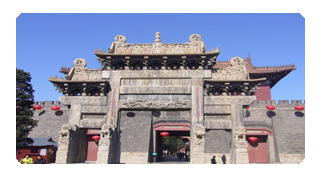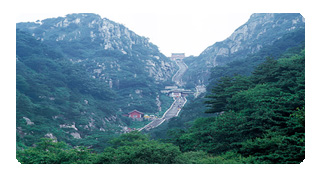Mt. Tai, called Daizong (means the principal mountain
of China) in ancient time, is located in the middle
part of Shandong province, spanning two cities (Tai'an
city and Jinan city) with total area of 426 square
kilometers. The weather in Mt. Tai is also mild and
the annual average temperature is about 17℃.
Mt. Tai is No.1 among the five most important mountains
in China, the state 5A-class tourist attraction, and
also the top 10 best National Civilized Spot in China.
Besides its historic relics, Mt. Tai boasts unique
natural scenery. The lofty peaks, deep valleys, spectacular
waterfalls, enchanting rocks and the centuries-old
pines and cypresses will undoubtedly encourage you
linger with no thought of leaving. The four wonders
of the mountain are Sunrises from the East, the Sunset
Glow, the Sea of Clouds and the Golden Belt along
the Yellow River. It would be a great pity for you
to miss the four wonders.
Mt. Tai is also famous for its imposing natural landscape.
There are four marvelous spectacles in Mt. Tai, and
they are sunrise watching on the peak, shine of sunset,
Yellow River watching in sunshine and sea of cloud.
What's more, Mt. Tai is considered to be a cultural
and historical museum. It is a famous place both of
Taoism and Buddhism.
 Dai
Temple
Dai
Temple
Dai Temple is a Taoist temple, was built under the
Qin (221-226 BC) and Han (206 BC-220 AD) dynasties.
It was then expanded under the Tang (618-907) and
Song (960-1279) dynasties. It situated to the north
of Taian City. Covering an area of 96,000 square meters
(24 acres). The Dai Temple is about 405 meters (1,329
feet) long from south to north and 237 meters (778
feet) wide from east to west.
It is one of the four most famous ancient architectural
complexes including the Forbidden City in Beijing,
the Temple of Confucius, the Kong Family Mansion and
the cemetery of Confucius in Qufu, and the Mountain
Resort in Chengde. It is also the largest and best-preserved
architectural complex on Mt. Tai, the various architectural
structures including the Tiankuang Hall, the Yaocan
Pavilion, the Zhengyang Gate, the Bell Tower, the
Drum Tower, the Han Dynasty Cypress Courtyard and
the Tang Dynasty Pagoda Tree Courtyard.
The Tiankuang Hall, the main construction at the Dai
Temple, was built in 1009 during the Song Dynasty
(960-1279). The hall has nine rooms and is 48.7 meters
long, 19.8 meters wide and 22.3 meters high. It was
built on a stone base surrounded by white stone-carved
railings.
Located at the back part of the east section is a
copper pavilion imitating a wooden structural style.
Built in 1615 during the Ming Dynasty, the pavilion
is one of the few precious copper-cast constructions
in China.
Another attraction is the Bronze Pavilion. Lying in
the northeast corner of the temple, the pavilion is
made of bronze castings. Intricate workmanship makes
it highly valuable, thus gaining its reputation as
one of the famous bronze pavilions in China.
 Mt.
Tai
Mt.
Tai
The leader of the 'Five Sacred Mountains', Mt. Tai
is located in the center of Shandong Province, lying
across the cities of Tai'an, Jinan and Zibo. The total
area of the mountain is 426 square kilometers with
a circumference of 80 kilometers. It has been a UNESCO
World Heritage Site since 1987.
Mt. Tai is in a superior geographic location with
abundant water and thermal resources, and its climate
belongs to the warm temperate zone half wetness monsoon
climate.
As regard to its historic position, in the ancient
times, Mt. Tai is a developed region-- in the lower
reaches of the Yellow River. As regard to its cultural
position, it is the center of Dongyi culture.
As a mountainous scenic spot, Mt. Tai has high values
in term of aesthetics and science, especially the
aesthetic value, which is the foundation for Mt. Tai
becoming a famous mountain in the history and the
world natural and cultural heritage today. Moreover,
in the Mt. Tai scenic culture, the natural scene plays
the key role with the literacy scene assisting. The
nature and culture penetrate into each other. Here
we can see the philosophy, aesthetics and science
idea about the harmonious development of Sky, Ground
and Human beings. Thereby, either from the point of
time or space, Mt. Tai contains extremely abundant
contents with high aesthetic, science and historic
value. We can say that Mt. Tai is the symbol of spiritual
culture of China and the unique heritage of the world.
Mt. Tai has 72 majestic peaks, magnificent waterfalls,
centuries-old pines and cypresses and fascinating
rocks. There are five tourist zones and two routes
up the mountain-one in the east and one in the west.
They meet at Zhongtian Gate and there are 6,293 steps
in the nine kilometers leading to the top. Scenic
spots include Longtan Reservoir, Zhongtian Gate, Five-Doctor
Pine, Duansong Hill, 18 Turns, South Gate to Heaven,
Bixia Tekmple, Zhanglu Terrace, Sun-Watching Peak,
Moon-Watching Peak. The four wonders of the mountain
are Sun Rises from the East, Golden Belt Along the
Yellow River, Beautiful Sunset and the Sea of Clouds.
Other attractive spots are the Rare Rock Dock, Fan
Cliff, Aolai Peak, Black Dragon Pool, Longevity Bridge,
and the Dragon Pool Waterfall.
Mt. Tai is one of China's mountain parks and is a
natural museum of history and art.



